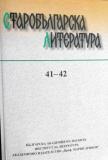Магьосницата от Аендор, пепелта, пепелянката и един библейски топос
The witch of Aendor, the Ashes, the Viper and a Biblical Topos
Author(s): Anna-Maria TotomanovaSubject(s): Language studies
Published by: Институт за литература - БАН
Summary/Abstract: THE WITCH OF AENDOR, THE ASHES, THE VIPER AND A BIBLICAL TOPOS ANNA-MARIJA TOTOMANOVA (SOFIA) (S u m m a r y) The article speculates on the origins of the expression влъхва попельница denominating the witch of Aendor (a woman with familiar spirit), to whom king Saul turned in his despair in order to obtain Samuel’s prophecy about the future of his bloodline and his own fate. It occurs on p. 423а18-19 of the Slavic version of the Chronicle of George Synkellos and does not correspond to the Greek word ἐγγαστρίμυθος in the Septuaginta. The ancient Greeks believed that sorcerers and necromancers (who prophesised to call upon the dead and ask them about the future) had πνεῦμα Πύθωνα and called them πυθώνες. In the Latin Vulgata magicians are referred to as people having python or contacting pythones. In the Bible the Greek idiom ðíå‡ìá Đýèùíá survived only in Acts 16:16, being replaced by ἐγγαστρίμυθος in the Old Testament as a translation of Hebraic 'ob ‘water skin; mumble’. King James Version describes sorcerers as having familiar spirits, i.e. being served by a spirit. We believe that Old Church Slavonic влъхва попельница reflects the Greek perception of the gift of divination as a result of having or being a python(issa). The Greek word was etymologised by the Slavic translator of Synkellos as deriving from the verb πύθομαι ‘to rot, decay’. The latter corresponds with the rare reading духъ прашьнъ for πνεῦμα Πύθωνα in some Old Church Slavonic Apostles and should be explained in the same way, since both stems прах- and попел- share the meaning ‘decay; mortality’. We suppose that the Bulgarian translator deliberately chose the noun попельница instead of the adjective попельнъ in order to identify the mythical dragon Python with the viper whose name was tabooed in South Slavic.
Journal: Старобългарска литература
- Issue Year: 2009
- Issue No: 41-42
- Page Range: 144-149
- Page Count: 6
- Language: Bulgarian
- Content File-PDF

